
April 2017
Annual Conference and Iverson Bell Symposium Shatters Attendance Records
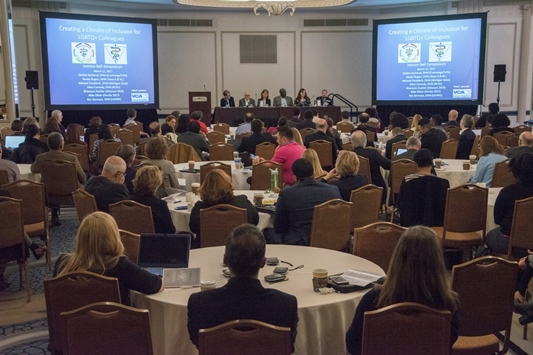 |
They gathered to collaborate, honor achievements, share strategies and work toward building a better future for academic veterinary medicine.
Themed “Building a Diverse Workforce to Serve Global Needs,” the conference focused on the development of diverse and inclusive environments within global academic veterinary medical institutions. Leading educators shared insights on building diversity and inclusiveness on campus through student and workforce recruitment, promoting intercultural competency, fostering appropriate culture and climate, and other topics.
Conference sessions ranged from “Bridging the Gap between Animal Care Professionals and the Spanish-Speaking Workforce,” to “Creating a Climate of Inclusion for LGBTQ+ Colleagues,” which focused on the importance of mentorship and supportive student groups such as Veterinary Students One in Culture and Ethnicity (VOICE) and the Broad Spectrum Veterinary Student Association. Other sessions focused on programs that encourage students to immerse themselves in other cultures through global research or other international projects.
Several sessions also focused on how to improve diversity in recruitment and admissions, from early attempts to interest K-4 students in veterinary medicine and other STEM careers to the use of more holistic, qualitative admissions practices.
In acknowledgement of the tremendous political changes underway in Washington, D.C., respected political analyst Peter Cook was invited to share his perspective and insights during a Friday afternoon plenary session. In a humorous and thoughtful presentation, Cook analyzed the factors that led up to one of the largest election upsets in American history and discussed the new administration.
During the AAVMC’s Advocacy Day on Thursday, March 9, more than 80 representatives conducted more than 140 visits with Congressmen, Senators and staffers. Several prestigious awards and honors were presented during the conference.
The biennial Iverson Bell Symposium honors Dr. Iverson Bell, a visionary who spent his life serving both veterinary medicine and education and who fought for the rights of the downtrodden and oppressed. Dr. Bell’s vision was one of equal opportunity for all and he rose above his era’s pervasive stereotyping and racism to achieve great things.
The 2017 AAVMC conference was sponsored by Boehringer-Ingelheim, Zoetis and AVMA-PLIT.
Learn more about the conference.
Schools Adopt More Holistic Admissions to Increase Student Body Diversity
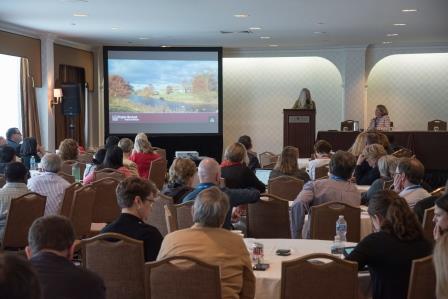 |
|
VMCVM’s Dr. Jacqueline Pelzer and Dr. Jennifer Hodgson address audience on holistic admissions during conference. |
In the past, the admissions staff at most schools would only focus on recruiting and accepting applicant number one, based upon formulas that gave priority to academic factors. However, some schools are taking a more holistic, comprehensive approach to admissions that increases consideration of qualitative factors when evaluating applicants.
The 2017 AAVMC Annual Conference and Iverson Bell Symposium featured two back-to-back sessions on holistic admissions. The sessions looked at holistic admissions as a method for creating a more diverse and inclusive student body, and by extension, workforce. Right now, for example, according to the U.S. Bureau of Labor Statistics, 84 percent of those currently working in science and engineering jobs in the U.S. are white or Asian males
The Virginia-Maryland College of Veterinary Medicine increased student body diversity by instituting holistic admissions. “To achieve equity in our society, we have to look at who is best to meet the needs of a diverse community,” said Virginia-Maryland’s Dr. Jacquelyn Pelzer, director of admissions and student services, “But first we must select a diverse population of students.” She offered the Association of American Medical Colleges’ definition of holistic admissions, which describes the process as, “a flexible, individualized way of assessing an applicant’s capabilities by which balanced consideration is given to experiences, attributes, and academic metrics in combination with what might contribute value as a student and physician.”
To increase diversity, Virginia-Maryland changed their evaluation formula. Instead of basing 80 percent of their decision on academic factors, they now base their decision 60 percent on academic factors and 40 percent on non-academic factors. To increase the ability to evaluate non-academic criteria, they require applicants to write two supplemental essays and undergo multiple mini-interviews. Every invited applicant is academically qualified for admission, but the interview process enables admissions staff to consider more qualitative factors, as well as the goal of increased diversity.
Virginia-Maryland also included the goal of increased diversity in their mission statement, actively recruits minorities, and decreased the requirement for animal or veterinary experience. This approach has enabled the school to increase the diversity of its entering class from seven to 35 percent based on ethnicity, race, gender and socioeconomic status, with no change in G.P.A.
Once students matriculate, there are mandatory diversity and inclusion workshops and access to more diversity-related student support services.
In another session on “Achieving Diversity through Intention: A Holistic Admission Process,” Dr. Suzie Kovacs, an assistant professor of epidemiology at the Western University of Health Sciences, said that the ideal veterinary medical school candidate is someone who, “succeeds academically, contributes to the profession and thrives in the profession. We’re not training students to be students but to contribute to the profession,” she said.
Non-academic factors that admissions officials might consider include an applicant’s intrinsic motivation, leadership, grit, resilience, communication skills, empathy, tenacity in the face of poor grades or adversity, success in a working environment, and high ethical standards.
Kovacs said that making the case for diversity is not just about fairness or social justice, but that a large body of literature shows that diversity enhances student learning, which then transfers to the workplace.
She added that our concept of diversity might include broadening our overall criteria for success. “How do we define success?” she asked. “We typically think of a successful graduate as one who gets board-certified and wins a teaching award, and that is true according to one definition of success. But someone who opens a low-cost clinic in an underserved area might also be considered a success, just in a different way.”
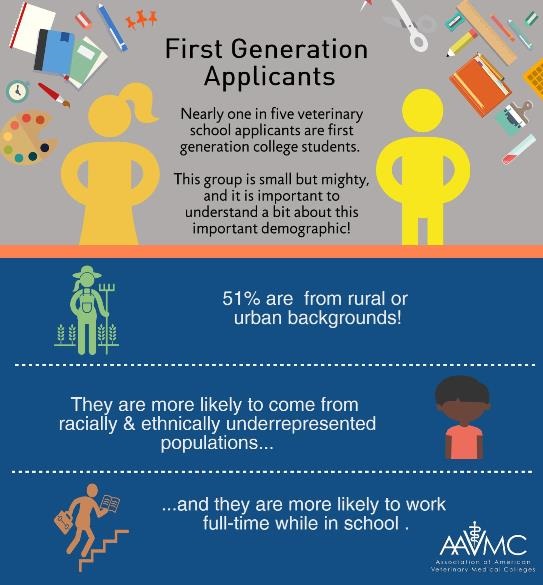 |
Zoetis Awards Scholarships to Rising Veterinary Students
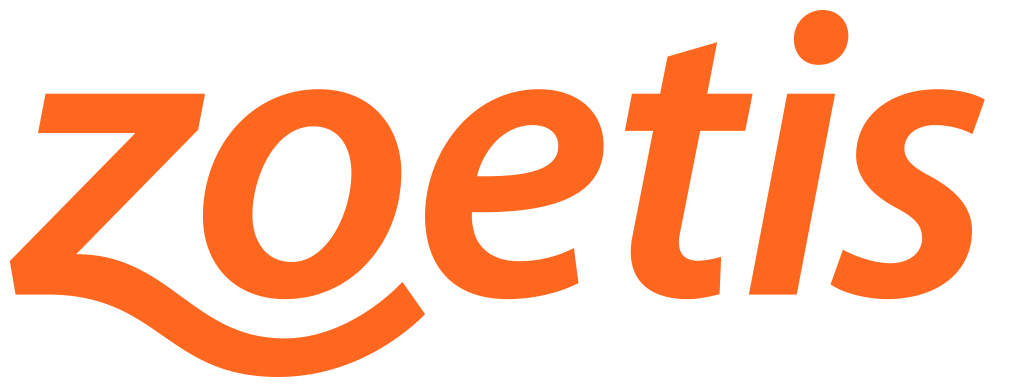 |
Now in its eighth year, the program awarded 315 scholarships to second- and third-year veterinary students. An additional 24 scholarships were awarded through partnerships with the American Association of Equine Practitioners (AAEP) and the American Association of Bovine Practitioners (AABP).
“Veterinary medical students will play a vital role in caring for animals and ensuring public health,” said Christine Jenkins, DVM, DACVIM, chief veterinary medical officer, U.S. Operations at Zoetis. “By awarding these scholarships, we hope to not only lessen the financial burden felt by many of these students, but to encourage every recipient to focus on their future and become leaders in the field.”
The scholarships recognize veterinary students who are already demonstrating academic excellence and a strong commitment to veterinary medicine and leadership.
This year, a record number of more than 1,700 applicants from universities throughout the United States and the Caribbean vied for the scholarships which were awarded in recognition of academic excellence, financial need, diversity, sustainability, leadership, and career path.
“Partnering with Zoetis enables us to help veterinary students offset the increasing costs of a medical education while providing these students with opportunities that might have otherwise been beyond their means,” said Dr. Andrew T. Maccabe, chief executive officer of the AAVMC. “These scholarships offer a way for students to manage every day expenses or study in-depth some of the most critical challenges our industry faces.”
The median debt of indebted graduates of U.S. colleges of veterinary medicine was $152,259 in 2016, according to AAVMC figures. This year’s scholarship recipients reflect a broad range of professional interests. Here are a few facts about the 2017 cohort of recipients:
- 33% are from racially and ethnically diverse backgrounds
- 31% are studying mixed animal medicine
- 14% are studying to practice food animal medicine
- 26% are going into small animal practice
- 4% percent are going into equine exclusive clinical practice
- 13% are entering academia (research and clinical), public health, government, or industry
- 11% will go into other areas, such as zoo/exotic animal, lab animal, wildlife, etc.
Zoetis discovers, develops, manufactures and markets veterinary vaccines and medicines, diagnostic products, genetic tests, bio-devices and provides a range of services for veterinarians, livestock producers and people who raise and care for farm and companion animals. With sales in more than 100 countries, Zoetis generated annual revenue of $4.9 billion in 2016. Zoetis employs about 9,000 people.
AMR Legislative Briefing Highlights Need for Action, One-Health Approach
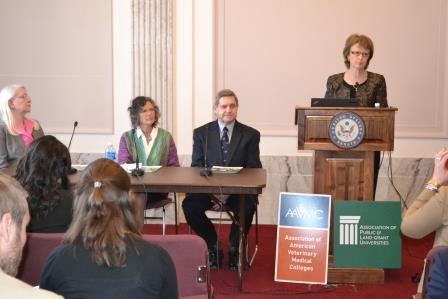 |
But effective policy development and federal government support are also key. To build awareness and cultivate support on Capitol Hill, the AAVMC and the APLU recently presented a legislative briefing.
The event, which attracted about 40 legislative staffers, government and industry officials and was presented with assistance from Senator Johnny Isakson (R-GA), illuminated the need for taking a multi-disciplinary, “One Health” approach to solving the AMR problem. Senator Al Franken (D-MN) introduced legislation last year in Congress to support that effort, and he is expected to reintroduce the legislation in the 115th Congress later this year.
Moderator Barbara Ekwall, senior liaison officer with the Food and Agriculture Organization (FAO) of the United Nations, moderated the event which featured three leading experts who focused on research, education and public policy.
The experts were:
- Dr. Terry Lehenbauer, associate professor, Population Health and Reproduction, University of California, Davis
- Hellen Gelband, associate director at the Center for Disease Dynamics, Economics and Policy
- Dr. Amelia Woolums, professor, Department of Pathobiology and Population Medicine, Mississippi State University.
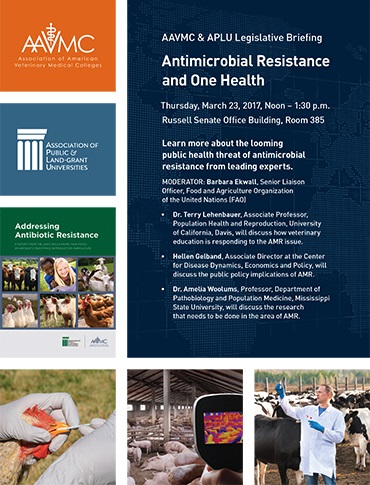 |
Dr. Lehenbauer addressed how veterinary education is responding to the AMR issue.
He explained how many details about the optimal selection of drug, dose and duration of antimicrobial treatment remain unknown, complicating efforts to combat the problem. As a solution, he stressed the need for more research to develop science-based AMR mitigation strategies.
Dr. Lehenbauer also discussed the Food and Drug Administration’s (FDA) Veterinary Feed Directive, which requires veterinary oversight and authorization for any approved therapeutic uses of medically important antimicrobials in feed for food-producing animals.
As of Jan. 1, 2017, the directive prohibits use for non-therapeutic use, such as growth promotion. Veterinarians will play a critical role in the directive’s implementation, but this will require effective communications channels and assistance getting the public to follow veterinary guidance, he said.
Dr. Woolums also discussed the need for more AMR-related research and the importance of a One Health approach where interdisciplinary teams of veterinarians, doctors, nurses, microbiologists and other scientists work together to answer some of the most important questions related to this pressing public health threat.
Attendees left the briefing with a broader understanding of the need to direct more resources to the development of research and science-based recommendations to combat AMR, as well as the need for a coordinated, multi-disciplinary approach to solving the problem.
Learn more about what the AAVMC is doing to combat AMR.
AAVMC’s Council on International Veterinary Medical Education Funds Charter Micro-Grants
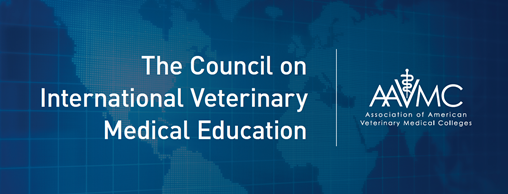 |
Established in 2016, CIVME includes eight members and their alternates from around the world. Regions represented include United States/Canada, United Kingdom/Ireland, Continental Europe, Australia/New Zealand, Africa, Latin America/Caribbean, China/South Asia/India and Middle East/North Africa.
CIVME’s mission is to advance high-quality veterinary education internationally through the promotion of inter-regional cooperation and the development and dissemination of best practices in academic veterinary medicine. Specific goals include:
- Communication and collaboration that advances international veterinary medical education
- Facilitate collaboration among educational researchers
- Dissemination of innovations and other educational advances that will magnify project impacts throughout regional organizations
In October 2016, CIVME announced an educational grant program for educators based on proposal topics that align with at least one of those goals.
Following a rigorous selection process led by Dr. Harold Bok (CIVME representative for continental Europe) CIVME announced that the first two grants would be funded at $5,000 each during the recent 2017 Annual Meeting of the AAVMC in Washington, D.C.
- Development of internationally relevant learning outcomes for undergraduate and postgraduate study in shelter medicine – Jenny Stavisky, University of Nottingham; Ruth Serlin, Royal Veterinary College; Ruth Van der Leij, Utrecht University; Brittany Watson, University of Pennsylvania; Rachel Dean, University of Nottingham.
- Evaluating core (Day-1) knowledge, skills and experience required to practice aquatic veterinary medicine, and determining what educational opportunities exist in veterinary curricula in the Americas, Europe, Africa and Asia-Pacific – David Scarfe, Aquatic Veterinary Associates International, LLC, and World Aquatic Veterinary Medical Association; Timothy Miller-Morgan, Oregon State University; Dušan Palic, Ludwig-Maximillians University (Germany); Howard Kai Hay Wong, City University of Hong Kong.
Annual Career Fair Keeps Getting Better and Better
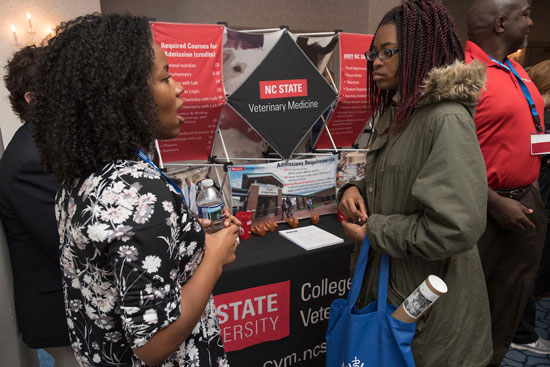 |
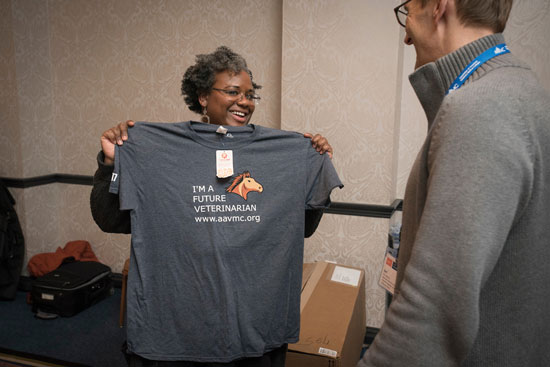 |
Students gathered information from more than a dozen veterinary medical schools at display tables staffed by college representatives, including admissions officers and deans.
In the exhibition hall, students and their parents asked questions and picked up informational materials about schools, admissions requirements, and veterinary careers.
After spending time in the exhibition hall, students attended information sessions on preparing to apply to veterinary school and heard a personal story about one speaker’s unique path to a career in equine veterinary medicine. Dr. Rachel Cezar outlined how she started showing horses at a young age, which led to involvement in the 4H Club and Future Farmers of America. She eventually attended veterinary school at Michigan State and is now the director of live animal imports for the United States Department of Agriculture.
In the session on how to get into veterinary medical school, the AAVMC’s Tony Wynne, director of admissions & recruitment affairs, told attendees that many factors determine the best school for prospective veterinary students, including “location, culture, climate and cost.”
He stressed that it’s “important to get on a campus and talk to students” to get a realistic assessment of the school, based on real-life experiences, and warned about the two major reasons for an application’s rejection: (1) applying to a school for which the applicant is not qualified and (2) not reading or following directions.
Members of the student panel also stressed the importance of culture and values. “Vet school is not just hard to get into but hard to stay in,” said veterinary student Felix Rodriguez from Louisiana State University. “You can get good experiences no matter where you go, but find a place where you feel comfortable and can find a support system. I’m Hispanic and I wanted to go to a more culturally diverse place where I could speak Spanish with other people.”
During information sessions, students could answer questions to earn t-shirts that said, “I am a Future Veterinarian.”
Government Relations Directors Update Students at Several Veterinary Colleges
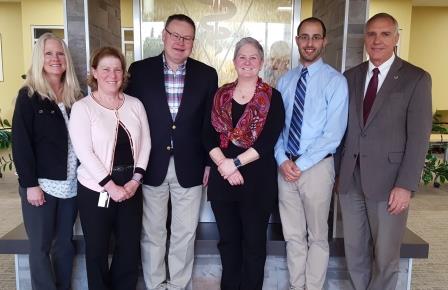 |
|
Cain and Luke with VMCVM officials. From left, Dr. Jacque Pelzer, Dr. Jennifer Hodgson, Cain, Luke, Vincent Tavella, Dean Cyril Clarke. |
Legislation like the Higher Education Act and the Veterinary Medicine Loan Repayment Program Enhancement Act materially affect important items like financial aid, loan repayments and career opportunities.
Some of these students are now more up to speed than they were, thanks to the efforts of AAVMC Governmental Affairs Director Kevin Cain and AVMA Government Relations Assistant Director Gina Luke.
Responding to student invitations, they have recently made presentations at the Tuskegee University College of Veterinary Medicine, the Auburn University College of Veterinary Medicine, the Purdue University College of Veterinary Medicine, and the Virginia-Maryland College of Veterinary Medicine. The VM presentation was webcast to interested students at other colleges.
Cain and Luke work closely together on Capitol Hill advocacy programs designed to advance the interests and promote the wellbeing of the veterinary profession.
Their presentations included a general overview of important issues on the current legislative agenda such as the reauthorization of the Higher Education Act, which contains provisions that affect financial aid as well as loan repayment. They also discuss the AVMA/AAVMC’s Fix-the-Debt campaign, and describe ways students can become more engaged in the process of promoting positive change.
“The students we’ve met with are very bright, very engaged, and very interested in learning more about this area,” said Cain, adding that they have also enjoyed the opportunity to tour the campuses and meet with college officials during the visits.
While the work demands of their professional schedules in Washington make it challenging to visit as many schools as they would like to, Cain and Luke have made their presentation available for viewing. Click here to learn more.
Veterinary Career Advisor Network (VetCAN) Contributing to Student Success
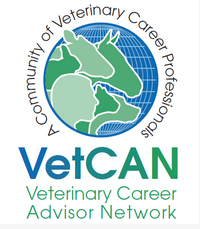 |
One method for doing that is creating coalitions of like-minded professionals at different institutions to share ideas and promote best practices. And the recently established Veterinary Career Advisor Network (VetCAN) is a perfect example of that.
The group, led by The Ohio State University’s Amanda Fark (fark.9@osu.edu), includes representatives from several AAVMC member institutions and welcomes career professionals who are working with students, alumni and prospective employers in veterinary medicine.
Their goal is to provide career development advising assistance for students, build and maintain relationships with employers, and help facilitate meaningful relationships between alumni and students.
They also seek to develop best practices and share ideas. While not officially connected with the Fix the Debt (FTD) Initiative, the current operating environment in veterinary medicine has highlighted the importance of the work that VetCAN is doing.
Considering the value of their work, the AAVMC has recently agreed to provide a modicum of administrative support to assist them with their program development efforts.
CEO Maccabe Concludes Air Force Career During Military Ceremony
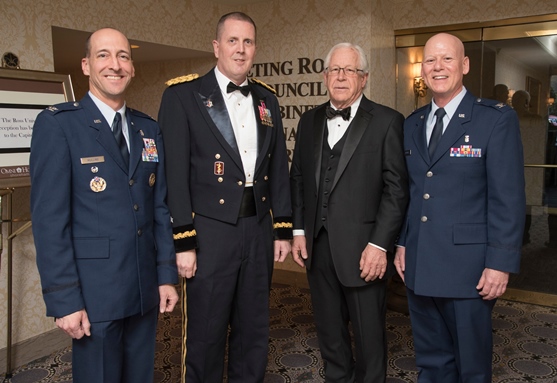 |
|
From left: Brigadier General Erik H. Torring, III, Colonel James A. Mullins, AVMA President Dr. Thomas Meyer, and AAVMC CEO Dr. Andrew T. Maccabe |
Military leaders, AAVMC and AVMA officials and more than 100 special guests gathered during the final evening of the AAVMC’s recent annual meeting for the official event that commemorated Maccabe’s 24 years of active and reserve service. Friends and guests, many clad in tuxedos and gowns, learned more about the essential role of veterinary medicine in the uniformed services and the life of the person who has led the AAVMC for the past five years.
The program got underway with the Presentation of Colors by a military honor guard and the National Anthem. Brigadier General Erik H. Torring, III, Chief of the U.S. Army Veterinary Corps, congratulated Maccabe and presented an overview of the history and mission of the veterinary profession within the armed services.
Colonel James A. Mullins, Associate Corps Chief for Public Health in the U.S. Air Force then congratulated Maccabe and provided additional detail on the profession’s responsibilities for public health, food production and sanitation, disease prevention and clinical care within the U.S. military.
Rear Admiral Terri R. Clark, Assistant Surgeon General of the United States Public Health Service, was unable to attend, but provided the following comments: “Aside from all of Andy’s degrees and accomplishments, his brilliant mind and dedication, I’ve always viewed him as a visionary and someone with absolute commitment to the betterment of our veterinary profession,” she wrote. “He is always positive, leaning forward and creating opportunities for our greater good.”
AVMA President Dr. Thomas Meyer offered congratulatory remarks on behalf of the organized veterinary medical community.
“It’s characteristic of Andy’s servant leadership personality and leadership style that he requested that my remarks not just focus on his career, but enable academic veterinarians to get a glimpse of military culture,” said Meyer, adding that the AVMA’s relationship with uniformed services remains strong and vital. “He has always strived to improve the profession, build relationships and craft a vision of what the future could be, especially in the area of diversity and inclusion … We thank you for your service, dedication and commitment.”
Following those remarks, Maccabe’s longtime friend, colleague and veterinary school classmate, Colonel Donald L. Noah, presented detailed remarks about the history of their 36-year friendship and their dual careers in the U.S. Air Force. Noah, who served as host and leader of the retirement ceremony, is now Director of the One Health Center at Midwestern University in Arizona and an associate professor of Public Health and Epidemiology at the university’s college of veterinary medicine.
In a winding speech that blended formal tribute with roast-like humor, Noah recalled their days in The Ohio State University College of Veterinary Medicine and the factors that influenced Maccabe to join the Air Force. Noah told a story in which he commissioned Maccabe using a roll of postage stamps imprinted with the U.S. flag when a real flag was unavailable.
Maccabe’s military career included 10 major duty postings within an active duty period from 1988-1998, during which he earned an MPH degree from Harvard University, and a reserve officer period from 2003-2017. Maccabe’s Air Force career concluded with service as Public Health Advisor to the Command Surgeon (IMA), HQ NORAD–USNORTHCOM at Peterson Air Force Base in Colorado.
Noah told the audience that Maccabe left active service in 1998 to earn a Juris Doctor degree magna cum laude from the University of Arizona in 2002. After completing an epic 2,000 mile bicycle tour of the United States, he said, Maccabe then joined the AAVMC as Associate Executive Director before realizing that he yearned to reconnect with the Air Force and begin a second phase of his military career. Noah again presided over the swearing in ceremony, this time in the Pentagon’s Flag Room. During his reserve officer service, Maccabe completed his first five-year tenure with the AAVMC, worked five years as the Centers for Disease Control’s Liaison to the Food & Drug Administration, and then rejoined the AAVMC in 2012 as executive director.
“You are a leader, warrior, veterinarian and a friend,” concluded Noah, whose own distinguished career included receipt of the Republic of Zaire’s Brevet de Participation for his efforts in helping control Africa’s deadly ebola outbreak in the early 1990’s.
Maccabe was then presented with the Defense Meritorious Service Medal (First Oak Leaf Cluster), his official retirement order from the Commander-in-Chief and a ceremonial U.S. flag as part of the ritual and tradition of a military retirement ceremony. General Torring presented him with his personal military challenge coin.
Then it was Maccabe’s turn to address the audience, and his remarks provided a glimpse of the life experiences that have forged his personal character and guided his career. He described his youthful experiences as a Boy Scout, his decision to become a veterinarian and his military career as life-shaping events. He said his experiences earning Eagle Scout status in the Boy Scouts provided his first lessons in leadership and imbued him with an abiding sense of the intrinsic value of providing service to others.
Becoming a veterinarian seemed like a good way to combine his interests in science, medicine, agriculture, and service to society, he said, and his first job in practice imparted important life lessons. He was hired by Dr. Charles Curie, a rural Ohio dairy practitioner who treated him immediately as an equal partner even though he was new and inexperienced. That experience in private practice, marked by long hours and hard work, provided defining lessons in personal integrity and fairness, he said.
Those same experiences in large animal veterinary medicine started him thinking about the USDA and then the military, and it was his military career that helped him realize the enduring values of “data centric customer service and continuous quality improvement.”
Maccabe said he has lived one life with two careers, underpinned by three oaths: Boy Scout, military, and veterinarian. He said his goal in life is to be useful, honorable and compassionate, and that those oaths and those experiences have helped him reach that goal. He said the Air Force core values of integrity, service and excellence have proven essential components of his military career and they will continue to shape the way he addresses his ongoing career in academic veterinary medicine.
Among several ceremonial gifts, Noah presented Maccabe with a large framed print of a U.S. postage stamp with a U.S. flag on it, which was followed by a rousing rendition of the Air Force Song.
Pet your Dog or Cat and Call Us in the Morning
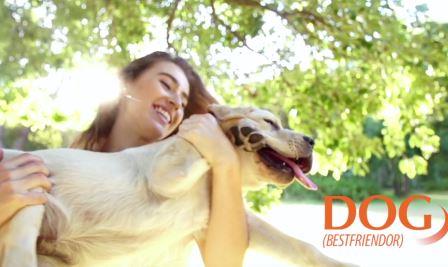 |
|
Click here to watch the dog video. |
For example, they catalogue and curate the largest collection of scientific data describing the beneficial aspects of the human/animal bond that exists.
Recently, animal health firm Zoetis, working closely with HABRI, unveiled an important public outreach campaign designed to help consumers understand more about that special relationship.
Called The Pet Effect, the campaign seeks to educate pet owners about the scientifically-documented health benefits of the human-animal bond and place their community veterinarian at the center of the conversation.
HABRI Executive Director Steven Feldman said he is exceptionally grateful to his colleagues at Zoetis “for creating an incredible campaign that will elevate and strengthen the human-animal bond.”
The campaign includes touching, humorous content designed to make a strong emotional connection with owners. Videos on dog and cat ownership have been produced in an amusing style that looks a lot like the prescription pharmaceutical commercials seen on television.
Those interested in learning more about the campaign can visit www.thepeteffect.org to learn more and download infographics and materials.
You won’t want to miss viewing the entertaining DOG and CAT videos, and you can visit the campaign’s Facebook page at The Pet Effect Facebook page.
Academic Veterinary Medicine in the News
A Cure for Clara: Gene Therapy Developed at Auburn University set for Human Trials
ABC-33-40
Young Black Bear Gets First Blood Transfusion at UT Vet. Medical Center
WVLT-TV
Illinois Vet College Releases Video Teaching Officers How to Treat Police Dogs Who Overdose on Opioids
Veterinary Practice News
Human Patients Could Benefit from a Study that’s Underway in Dogs with a Fatal Paralytic Disease
Tufts Now
On the Horizon: How Dogs may Help Fight Bone Cancer
CBS News
Vet School Losing State Funding Matters for More Than Just Dogs and Cats
The Daily Pennsylvanian
Vaccinating Pets can Have Complications but it is Unlikely, says Veterinarian
CNC News
UC Davis Plans $508 Million Upgrade
Veterinary Practice News
Zoetis, AAVMC Announce 315 Scholarships to Vet Students
Veterinary Practice News
Born Without Paws, this Rescue Puppy gets a Second Chance with Prosthetic Ones
Merced Sun Star
Merck Animal Health Supports Scholarship for 34 Veterinary Students
Bovine Veterinarian
VIN Foundation launches Student Debt Center
JAVMA
Texas Colleges Bring Canine Anatomy VR to SXSW
Veterinary Practice News
Biomarker Could Lead to Personalized Therapies for Prostate Cancer
Eureka
NIFA Announces $2.4m to Relieve Vet Shortages
Feedstuffs
“Like” us on Facebook or follow us on Twitter:




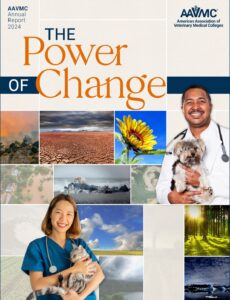
SHARE